鼬獾Chinese Ferret Badger
1. 分类Taxonomy
食肉目Carnivora
鼬獾属Melogale
鼬獾 Melogale moschata(Gray,1831),英文名Small-toothed Ferret Badger、Chinese Ferret Badger、Chinese Ferret-badger、Small-toothed Ferret-badger
2. 保护级别Conservation Assessment
l 我国三有保护物种,指有益的、有重要生态价值、有科学研究价值的野生动物
Beneficial, ecologically important and scientifically valuable wildlife under protection of China
l IUCN红色名录低危物种;
Least Concerned species on IUCN Red List
3. 形态特征Physical Description
鼬獾头体长31-42厘米,尾长13-21厘米,体重0.5-1.6千克。
与同域分布的猪獾和亚洲狗獾相比,鼬獾的体型明显更小更纤细,尾巴长且蓬松,占身体比例更大。颈部粗短,耳壳短圆而直立,眼小,毛色变异较大,体背淡灰褐或黄灰褐色、暗紫灰色到棕褐色不等,腹部苍白色、黄白色、肉桂色到杏黄色不等(图1)。
The ferret badger has a body length of 31-42 cm, a tail length of 13-21 cm and a weight of 0.5-1.6 kg.
Compare to sympatrically distributed hog-nosed badger and Asian badger, ferret badger is significantly smaller and more slender, with a longer, shaggy tail. The neck is thick and short; the ear is short, round and erect; the eyes are small; and the color of the hair varies greatly. The back of the body is grayish-brown, yellowish-gray, dark purplish-gray to tan, and the abdomen is pale, yellowish-white, cinnamon to apricot yellow (Fig. 1).
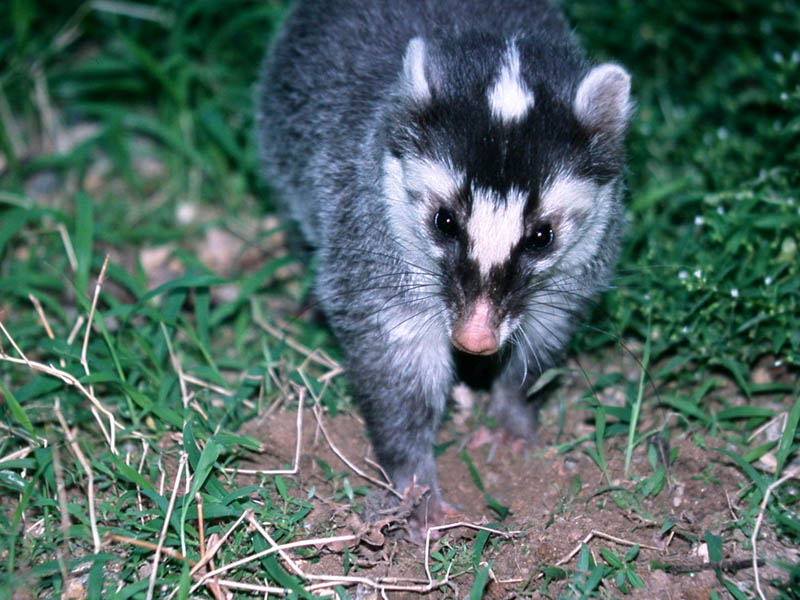
图1. 鼬獾实体图(来源不明)
Figure 1. Chinese ferret badger (origin: unknown)
4. 地理分布Geographic Range
分布于中国、印度、老挝、缅甸、越南(图2)。
中国分布在海南、广东、广西、贵州、云南、四川、安徽、湖北、湖南、江苏、上海、浙江、江西、福建、重庆、台湾。
The species distributes in China, India, Laos, Myanmar and Vietnam (Fig. 2).
In China, they distribute in Hainan, Guangdong, Guangxi, Guizhou, Yunnan, Sichuan, Anhui, Hubei, Hunan, Jiangsu, Shanghai, Zhejiang, Jiangxi, Fujian, Chongqing, and Taiwan.
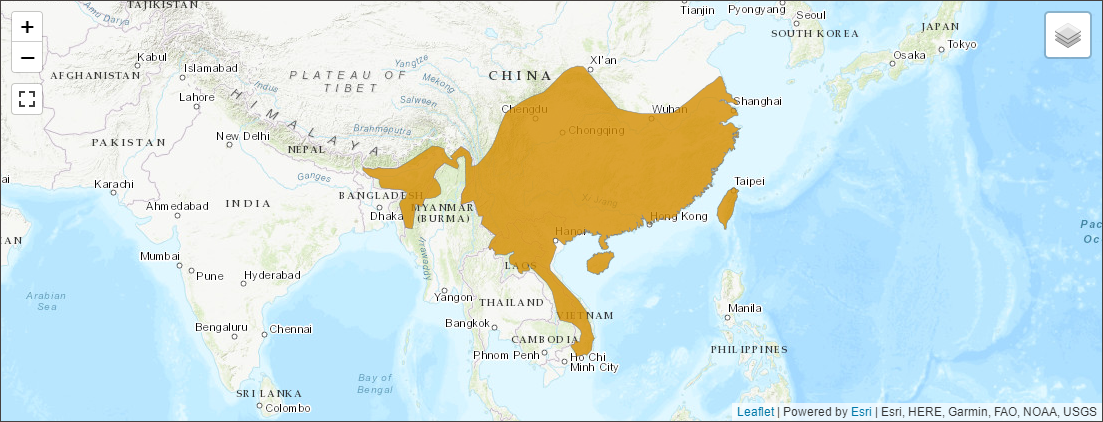
图2. 鼬獾世界范围地理分布图(来源IUCN)
Figure 2. Geographic range of Chinese ferret badger around the world (origin: IUCN)
5. 栖息环境Habitat
鼬獾栖于河谷、沟谷、丘陵及山地的森林、灌丛和草丛中。喜欢在海拔2000米以下的低山常绿落叶、阔叶林带活动,亦在农田区的土丘、草地和烂木堆中栖息。
Ferret badgers inhabit forests, thickets and grasses in river valleys, gullies, hills and mountains. They like to live in the evergreen and deciduous broad-leaved forest belt in the low mountains below 2000 meters, and also live in the mounds, grasslands and rotten wood piles in the farmland.
6. 生活习性Ecology
6.1 食物Food Habits
鼬獾杂食性。以蚯蚓、虾、蟹、昆虫、泥鳅、小鱼、蛙和鼠形动物等为食,亦食植物的果实和根茎。春季以昆虫、小鱼、蛙和植物的根茎等为主食;夏季则以昆虫鳞翅目的蛾类、蛙类为主;食物丰富的秋季,除捕食小型动物外,还采食山楂、山芋和其他野果;秋末至冬季,食物以无脊椎动物占优势,植物的果实和根茎类也相应地增加。
Ferret badgers are omnivorous. They feed on earthworms, shrimp, crabs, insects, loaches, small fish, frogs and rodents, as well as fruits and roots of plants. In spring, their main food are insects, small fish, frogs and roots of plants; In summer, they shift to moths under Lepidoptera and frogs. In autumn when food is ample, in addition to prey on small animals, they also eat hawthorn, sweet potato and other wild fruit; From late autumn to winter, invertebrates dominate the diet composition, and the fruits and roots of plants increase accordingly.
6.2 社群Sociality
独居生活,偶见2-4只个体一起活动。
They are solitary, occasionally gather in small group of 2-4 individuals
6.3 领域Home Range
家域范围0.5-4.7平方公里。
The home range size is 0.5-4.7 km2.
6.4 节律Rhythm
鼬獾夜行性(图3、4),入夜后成对出来活动(图4),凌晨回洞,个别活动和觅食时间可达拂晓。白天一般都隐居洞中,偶尔亦在洞穴周围的草木丛休息。若遇惊动,便潜入洞中。
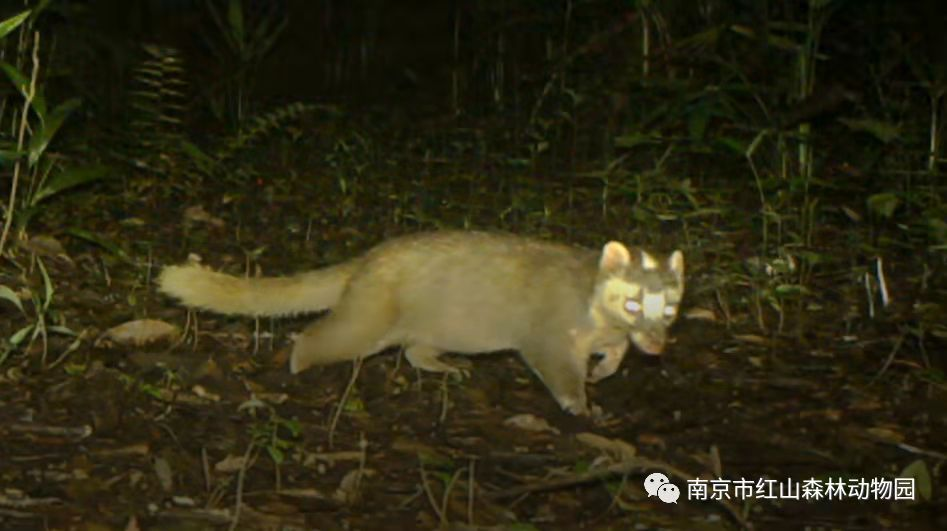
图3. 夜里行动的鼬獾(来源红山动物园)
Figure 3. Ferret badger active at night (origin: Hongshan Zoo)
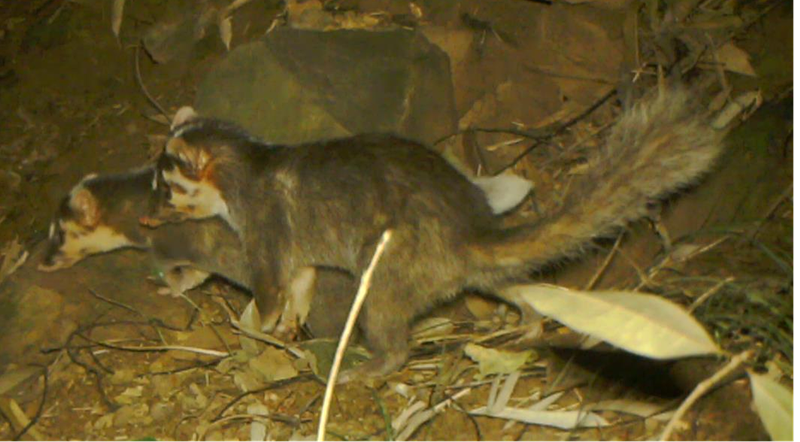
图4. 成对行动的鼬獾(来源红山动物园)
Figure 4. Ferret badger in pair (origin: Hongshan Zoo)
鼬獾活动的季节性变化较明显,春、冬季节常活动于阳坡林缘和灌丛间;夏、秋季节多活动于阴坡林内和河谷的灌丛间。喜好在干涸的水沟或小溪边觅食,用脚爪和鼻吻扒挖食物,常留下半月形的翻掘泥土的痕迹。活动范围小而固定,出入循一定路径,依河沟谷地的坎壁下或小山梁边往返穿行而留下显著的“兽径”。
Ferret badgers are nocturnal (Fig. 3, 4) and may come out in pairs at night (Fig. 4). They return to their burrows at dawn, and their individual activities and foraging time can reach sunset. During the day, they usually hide in the cave, and occasionally rests in the vegetation around the cave. If alarmed, they will slide into the hole.
The seasonal activity variation of ferret badger was obvious, ferret badger occurs mainly at the edge of sunny slope forest and thicket in spring and winter, while in shady slope forest and valley between the thickets in summer and autumn. It is fond of foraging in dry ditches or streams, picking up food with its paws and nose, often leaving traces of half-moon marks on digging soil. They have small and fixed range of activities, and move on certain paths. And they will leave significant "beast paths" when move back and forth along river valley wall or the edge of the mountain.
6.5 移动Moving Method
活动较迟钝,行走时腹部几乎贴地,常以鼻贴近地面搜索前进。
Their activity looks dull. When walking, their abdomen almost reach the ground, and the nose is often close to the ground to searching.
7. 繁殖Reproduction
鼬獾每年繁殖1次,3月发情交配,大多发生在同一群中,雌雄互相交配,无争偶现象,交配后,雌雄仍在一起觅食和栖居。
5-6月在洞穴中产仔,每胎产1-4仔。母兽带幼仔哺乳2个月,其后,母兽离开洞穴与幼仔分离,1年后幼仔达到性成熟。
Ferret badgers breed once a year and mate in March. Most of mating occur in the same group. The males and females mate with each other without any mating competition. After mating, the males and females still forage and inhabit together.
In May and June, cubs are born in the cave, with 1-4 cubs per litter. The mother nurses its young for 2 months. After that, it leaves the burrow along with its young. One year later, the young reach sexual maturity.
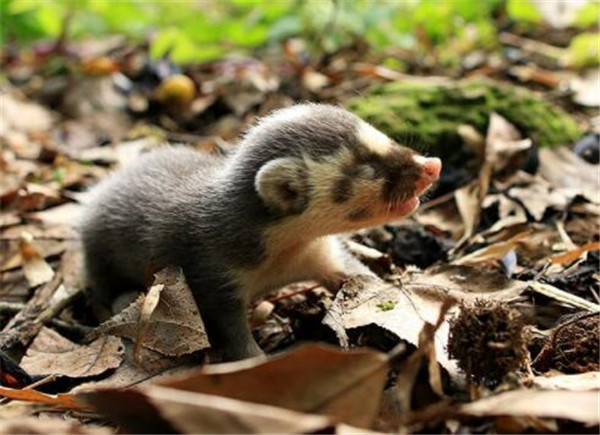
图5. 鼬獾幼仔图(来源http://zumengchong.com/)
Figure 5. Cub of ferret badger (origin: http://zumengchong.com/)